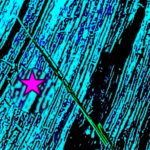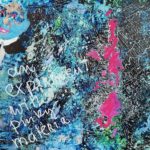 About three years ago I started to paint pictures, to want to become a “painter”. For this new role in my life I gave myself the hausmeister-heuser name.
About three years ago I started to paint pictures, to want to become a “painter”. For this new role in my life I gave myself the hausmeister-heuser name.
My tools were and still are: a normal smartphone, a stylus, a laptop, a printer and a few felt pens. Everyday devices of today. With these tools I create pictures that are both at the same time: reproductions and unique specimens. They exist as files, but almost all of them get a special, unique finish, even when printed. I have found a formulation for this, I give them a “significant additional content” (SAC), a “perceptible addition”.
But now what I am concerned with this time. I start from the assumption that basically every picture is fluid (i.e. always the beginning and end of a creative sequence at the same time). So I mean not only my pictures, but really all of them. I can make every picture my own, but also: everybody can make my pictures his own. This appropriation happens by intervening in the semantics of an image, for example by transforming the image of a day scene into the image of a night scene. I call my approaches to images painting strategies; for the example mentioned, the strategy is called “semantic transfer”.
The painting strategies originate in my head, they have special meanings for me. I have developed them on the basis of my possibilities. I am aware of the limitations of my abilities, but the possibilities to use these limitations creatively are unlimited. Another example is the painting strategy I call “transformation”. On my website, under the title “The making of the bizzy lizzies”, I have tried to illustrate the process of creating the painting with the bizzy lizzies. I speak of a transformation in this case, because the starting point of the development of the picture with the picture that was created at the end has no meaningful connection to the picture that was created at the end, except the process itself. What is the status of these pictures that have been created in these strange ways?
The starting point of my pictures is almost always a photograph. Either I took it spontaneously, or it is a photo that I took exactly because I wanted to paint or paint over it. My, somewhat prosaically expressed, production process is not identical for all pictures, but on the contrary: it is specific for almost every picture. For example. Let us take the starting point for a series of pictures: The walls of the VISCVLE restaurant/bar in Lüneburg. These walls have something picturesque about them from the very beginning. A whole cosmos of different shades of red and grey, sometimes towards violet, sometimes towards orange.
With my mobile phone camera I took pictures of different parts of the old masonry exposed there, then printed them out, then painted them slightly coloured as well as covering them in places. This resulted in my first moment of satisfaction. This finally led to a photo or scan of this first picture. This printout in turn became the starting point for a second processing. I think again about the detail, as well as the colour effect as a whole, work on these aspects, print again and spontaneously add something of mine. This extension is an attempt in terms of image aesthetics. It does not automatically devalue the first picture. It can be an addition, sometimes even a reinterpretation (semantik transfer) and reorganization of the image (transformation). This means that for each sequence the question of strategy arises anew. There can and may be different perceptions of the images created in this way. One may prefer the simple or the labyrinthine – all is well! Nobody has only one sensation when looking at a painting..



